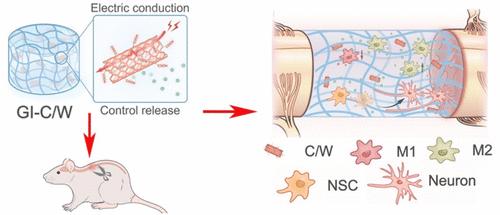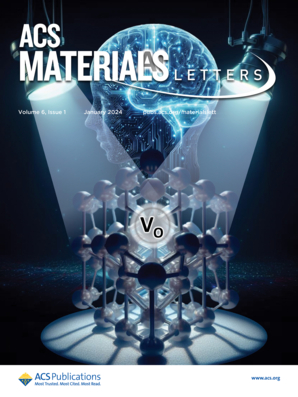通过碳纳米管水凝胶持续释放沃戈宁恢复脊髓损伤后的运动和膀胱功能
IF 9.6
1区 化学
Q1 MATERIALS SCIENCE, MULTIDISCIPLINARY
引用次数: 0
摘要
脊髓损伤(SCI)会造成结构和神经细胞损伤,导致运动和膀胱功能障碍。有限的再生能力和 SCI 介导的炎症加剧了二次损伤,阻碍了神经功能的恢复。为了促进神经再生和调节炎症反应,我们开发了一种具有电特性和持续释放中药成分沃戈宁(Wog)的双功能支架。在光交联明胶水凝胶中加入 Wog 负载碳纳米管后,功能性水凝胶的导电性和机械性能得到改善,Wog 的持续释放行为增强了神经干细胞的迁移和神经源性分化以及血管化,抑制了受损脊髓和膀胱逼尿肌和括约肌的促炎反应和纤维化,从而加速了运动和神经源性下尿路功能的恢复。我们的研究提出了一种解决脊髓损伤后运动和膀胱功能障碍的新策略,重点是促进神经再生和调节炎症微环境。本文章由计算机程序翻译,如有差异,请以英文原文为准。

Restoration of Motor and Bladder Functions after Spinal Cord Injury via Sustained Wogonin Release from Carbon Nanotube Incorporated Hydrogels
Spinal cord injury (SCI) results in structural and neural cell damage, leading to motor and bladder dysfunction. The limited regenerative capabilities and SCI-mediated inflammation exacerbate secondary damage and impede neurological recovery. To enhance neural regeneration and modulate inflammatory responses, a dual-functional scaffold with electrical properties and sustained release of wogonin (Wog), an ingredient in Chinese herbal medicines, was developed. With incorporation of Wog-loaded carbon nanotubes into photo-cross-linkable gelatin hydrogel, improvements in electrical conductivity and mechanical properties and sustained Wog release behavior of the functional hydrogel enhanced migration and neurogenic differentiation of neural stem cells and vascularization and suppressed pro-inflammatory responses and fibrosis in damaged spinal cord and detrusor and sphincter muscles of bladder, consequently accelerating motor and neurogenic lower urinary tract function recovery. Our work presents a novel strategy for addressing motor and bladder dysfunction after SCI, focusing on promoting neural regeneration and modulating the inflammatory microenvironment.
求助全文
通过发布文献求助,成功后即可免费获取论文全文。
去求助
来源期刊

ACS Materials Letters
MATERIALS SCIENCE, MULTIDISCIPLINARY-
CiteScore
14.60
自引率
3.50%
发文量
261
期刊介绍:
ACS Materials Letters is a journal that publishes high-quality and urgent papers at the forefront of fundamental and applied research in the field of materials science. It aims to bridge the gap between materials and other disciplines such as chemistry, engineering, and biology. The journal encourages multidisciplinary and innovative research that addresses global challenges. Papers submitted to ACS Materials Letters should clearly demonstrate the need for rapid disclosure of key results. The journal is interested in various areas including the design, synthesis, characterization, and evaluation of emerging materials, understanding the relationships between structure, property, and performance, as well as developing materials for applications in energy, environment, biomedical, electronics, and catalysis. The journal has a 2-year impact factor of 11.4 and is dedicated to publishing transformative materials research with fast processing times. The editors and staff of ACS Materials Letters actively participate in major scientific conferences and engage closely with readers and authors. The journal also maintains an active presence on social media to provide authors with greater visibility.
 求助内容:
求助内容: 应助结果提醒方式:
应助结果提醒方式:


